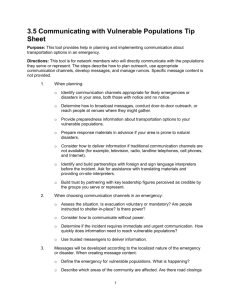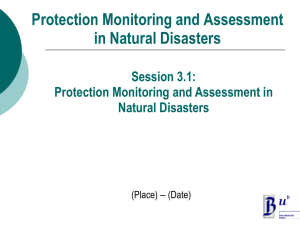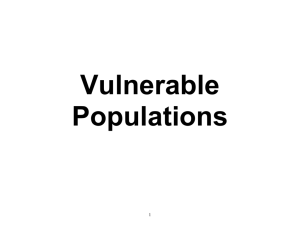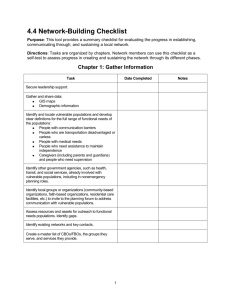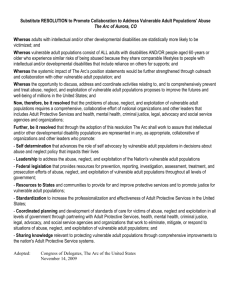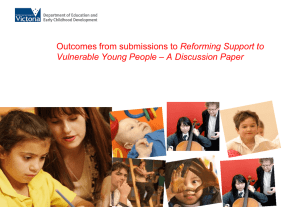Communication Performance Measurement
advertisement
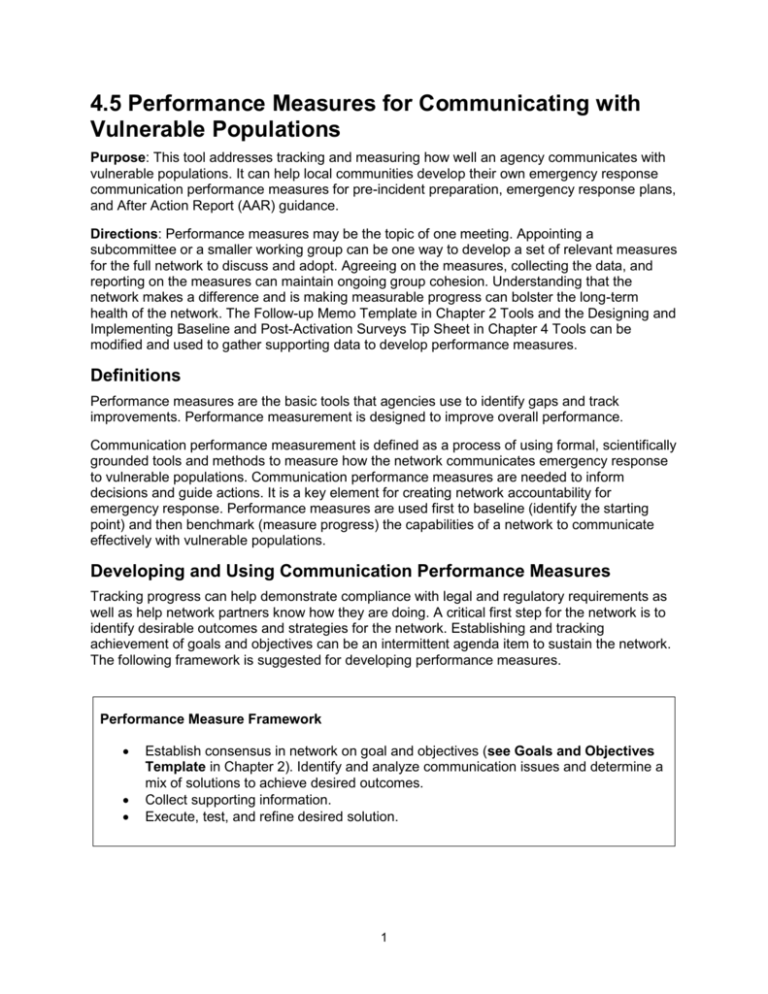
4.5 Performance Measures for Communicating with Vulnerable Populations Purpose: This tool addresses tracking and measuring how well an agency communicates with vulnerable populations. It can help local communities develop their own emergency response communication performance measures for pre-incident preparation, emergency response plans, and After Action Report (AAR) guidance. Directions: Performance measures may be the topic of one meeting. Appointing a subcommittee or a smaller working group can be one way to develop a set of relevant measures for the full network to discuss and adopt. Agreeing on the measures, collecting the data, and reporting on the measures can maintain ongoing group cohesion. Understanding that the network makes a difference and is making measurable progress can bolster the long-term health of the network. The Follow-up Memo Template in Chapter 2 Tools and the Designing and Implementing Baseline and Post-Activation Surveys Tip Sheet in Chapter 4 Tools can be modified and used to gather supporting data to develop performance measures. Definitions Performance measures are the basic tools that agencies use to identify gaps and track improvements. Performance measurement is designed to improve overall performance. Communication performance measurement is defined as a process of using formal, scientifically grounded tools and methods to measure how the network communicates emergency response to vulnerable populations. Communication performance measures are needed to inform decisions and guide actions. It is a key element for creating network accountability for emergency response. Performance measures are used first to baseline (identify the starting point) and then benchmark (measure progress) the capabilities of a network to communicate effectively with vulnerable populations. Developing and Using Communication Performance Measures Tracking progress can help demonstrate compliance with legal and regulatory requirements as well as help network partners know how they are doing. A critical first step for the network is to identify desirable outcomes and strategies for the network. Establishing and tracking achievement of goals and objectives can be an intermittent agenda item to sustain the network. The following framework is suggested for developing performance measures. Performance Measure Framework Establish consensus in network on goal and objectives (see Goals and Objectives Template in Chapter 2). Identify and analyze communication issues and determine a mix of solutions to achieve desired outcomes. Collect supporting information. Execute, test, and refine desired solution. 1 Criteria for Selecting Performance Measures To build a performance measurement system, select a limited number of quantifiable measures that provide coherent guidance to enhance emergency response communication within and through a network of responders. The measures should be systemic in scope (encompassing the most important functions and objectives of the network), address observable events, and produce actionable intelligence. Communication Performance Measurement The following tables provide suggestions for state, regional, and local network conveners (public, private, and nonprofit) to use in measuring the effectiveness of the network in communicating with vulnerable populations. Begin by asking the following questions. (Present tense indicates expectations/planning; past tense indicates a recent activation of the network). How is/was the network expected to perform in an emergency? How does/did the network function in an emergency (small or large)? How does/did collaboration assist in communicating with vulnerable populations? How does/did collaboration help accomplish communication goals? How does/did collaboration improve management and deployment of transportation resources? Overall Performance Measures Building a performance measurement system requires the development of a limited set of measures that are scientifically well-grounded, relevant to the concerns of stakeholders, and feasible to implement given the current state of available data collection and information systems. The communication network around transportation options in an emergency can adopt goaloriented performance measures and object-oriented performance metrics to address the needs of vulnerable communities and to assess how the network is doing relative to the known concerns, such as the fear they would be left behind in a major calamity. To help mitigate this fear, performance measure planning should be inclusive and include members of vulnerable populations and their representative organizations. This will help identify, fine tune, and update effective performance measures. It will also help identify, address, and mend basic structural barriers that can fracture network communication. 2 Table A: Overall Example Performance Measures Goals Objective Baseline Measures Temporal Measures 6 month 1 year Regional demographics; # of identified vulnerable population groups in region; # of special needs % of vulnerable population with identified contacts compared to total vulnerable population groups (# of groups and est. population per group) x x x x x x x x x x x x x x Enhance Interagency Response Capability Reduce Impact Strengthen Interagency Preparedness Enhance Capability # reduction in response time % reduction in response time Advance Interagency Communication Ability Integrate Communication Channels # usage of media types (print, social networks, radio, cell phones, and TV) % usage of media types (print, social networks, radio, cell phones, and TV) Improve Network Outreach Functionality Strengthen Community Relationships # of outreach training activities that are community based % of outreach training activities that are community based Improve Network Outreach Functionality Broaden Community Relationships # of translators/# of language groups represented/# of language groups not represented (including ASL) % of community language groups represented by translators compared to total language groups (# of groups and est. populations of groups if feasible) Develop Network Personnel Competency Provide Outreach and Communication Training # of workers trained by key employment or service categories % of workers trained by key employment or service categories Strengthen Network Relationships Maintain Network Database Approx. time spent on planning activities with network partners (including planning meetings, exercises, network tests, joint efforts, such as community meetings) % of time spent on planning activities with network partners; # meetings, conference calls, etc., # of participants # of community-based and faith-based organizations, direct service providers, community leaders, neighborhood captains by network partners % of faith-based and community-based organizations, direct service providers, community leaders, neighborhood captains by network partners Develop Communication Database Develop, Maintain, and Share Community Outreach Database 3 Goals Updated Communication Plan and Database Objective Keep Contacts Up to Date Baseline Measures # of contacts; # agreeing to continue involvement Temporal Measures 6 month 1 year Contact database update frequency: Quarterly? Annually? Update completed on time? % of contacts agreeing to remain on list. % providing substitute. x x The development of performance measurement systems requires an investment of resources. Acquiring and maintaining those resources also means that the benefits of performance measurement will be made clear to those with influence over resource allocation within the network’s participating agencies. Ultimately, the development of an effective performance measurement system will require that senior officials in federal, state, regional, and local agencies make a commitment to work closely with vulnerable populations when developing objective information to assess and improve communication systems. Table B: Communication Readiness Example Baselines and Benchmarks Action Base Line Benchmark Strategic Campaigns to Increase Volunteerism Annual or seasonal (e.g., paired with 1 per year (minimum) threat readiness planning –hurricane season, wildfires, tornado, etc.) Updated Communication Readiness Plan Annual 1 per year (example) Enhancing Communication Effective communication is seldom one-way. It needs to be two-way. As such, an effective communication process requires a feedback loop. Several tools in the Chapter 4 Tools section are intended to support that need: Designing and Implementing Baseline and PostActivation Surveys Tip Sheet, Post-Event Evaluation Form and the Contact Information Update Template. In addition, regular meetings of network members – either virtual or face-toface – with performance measurement on the agenda will help ensure that the right actions and responses are being measured and that the network is measurably improving in meeting the communication needs of vulnerable populations. 4
